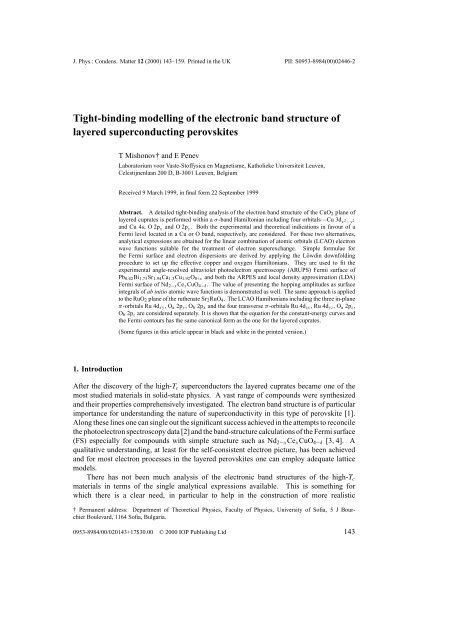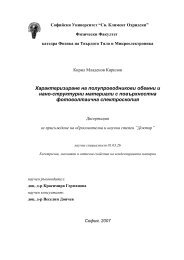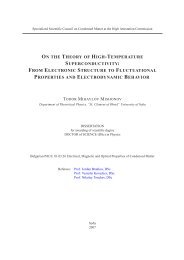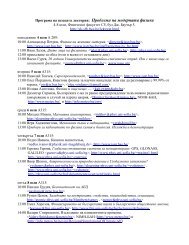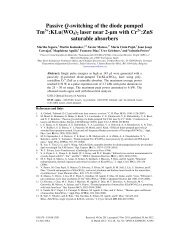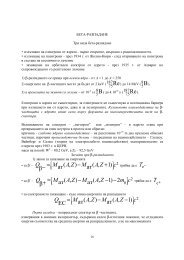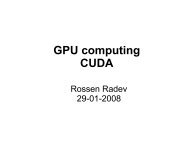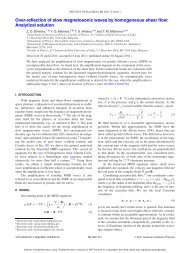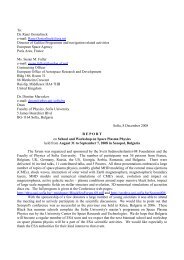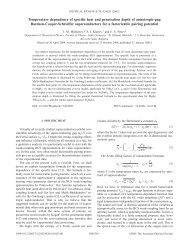Tight-binding modelling of the electronic band structure of layered ...
Tight-binding modelling of the electronic band structure of layered ...
Tight-binding modelling of the electronic band structure of layered ...
- No tags were found...
Create successful ePaper yourself
Turn your PDF publications into a flip-book with our unique Google optimized e-Paper software.
J. Phys.: Condens. Matter 12 (2000) 143–159. Printed in <strong>the</strong> UK PII: S0953-8984(00)02446-2<strong>Tight</strong>-<strong>binding</strong> <strong>modelling</strong> <strong>of</strong> <strong>the</strong> <strong>electronic</strong> <strong>band</strong> <strong>structure</strong> <strong>of</strong><strong>layered</strong> superconducting perovskitesT Mishonov† and E PenevLaboratorium voor Vaste-St<strong>of</strong>fysica en Magnetisme, Katholieke Universiteit Leuven,Celestijnenlaan 200 D, B-3001 Leuven, BelgiumReceived 9 March 1999, in final form 22 September 1999Abstract. A detailed tight-<strong>binding</strong> analysis <strong>of</strong> <strong>the</strong> electron <strong>band</strong> <strong>structure</strong> <strong>of</strong> <strong>the</strong> CuO 2 plane <strong>of</strong><strong>layered</strong> cuprates is performed within a σ -<strong>band</strong> Hamiltonian including four orbitals—Cu 3d x 2 −y 2and Cu 4s, O 2p x and O 2p y . Both <strong>the</strong> experimental and <strong>the</strong>oretical indications in favour <strong>of</strong> aFermi level located in a Cu or O <strong>band</strong>, respectively, are considered. For <strong>the</strong>se two alternatives,analytical expressions are obtained for <strong>the</strong> linear combination <strong>of</strong> atomic orbitals (LCAO) electronwave functions suitable for <strong>the</strong> treatment <strong>of</strong> electron superexchange. Simple formulae for<strong>the</strong> Fermi surface and electron dispersions are derived by applying <strong>the</strong> Löwdin downfoldingprocedure to set up <strong>the</strong> effective copper and oxygen Hamiltonians. They are used to fit <strong>the</strong>experimental angle-resolved ultraviolet photoelectron spectroscopy (ARUPS) Fermi surface <strong>of</strong>Pb 0.42 Bi 1.73 Sr 1.94 Ca 1.3 Cu 1.92 O 8+x and both <strong>the</strong> ARPES and local density approximation (LDA)Fermi surface <strong>of</strong> Nd 2−x Ce x CuO 4−δ . The value <strong>of</strong> presenting <strong>the</strong> hopping amplitudes as surfaceintegrals <strong>of</strong> ab initio atomic wave functions is demonstrated as well. The same approach is appliedto <strong>the</strong> RuO 2 plane <strong>of</strong> <strong>the</strong> ru<strong>the</strong>nate Sr 2 RuO 4 . The LCAO Hamiltonians including <strong>the</strong> three in-planeπ-orbitals Ru 4d xy ,O a 2p y ,O b 2p x and <strong>the</strong> four transverse π-orbitals Ru 4d zx ,Ru4d yz ,O a 2p z ,O b 2p z are considered separately. It is shown that <strong>the</strong> equation for <strong>the</strong> constant-energy curves and<strong>the</strong> Fermi contours has <strong>the</strong> same canonical form as <strong>the</strong> one for <strong>the</strong> <strong>layered</strong> cuprates.(Some figures in this article appear in black and white in <strong>the</strong> printed version.)1. IntroductionAfter <strong>the</strong> discovery <strong>of</strong> <strong>the</strong> high-T c superconductors <strong>the</strong> <strong>layered</strong> cuprates became one <strong>of</strong> <strong>the</strong>most studied materials in solid-state physics. A vast range <strong>of</strong> compounds were syn<strong>the</strong>sizedand <strong>the</strong>ir properties comprehensively investigated. The electron <strong>band</strong> <strong>structure</strong> is <strong>of</strong> particularimportance for understanding <strong>the</strong> nature <strong>of</strong> superconductivity in this type <strong>of</strong> perovskite [1].Along <strong>the</strong>se lines one can single out <strong>the</strong> significant success achieved in <strong>the</strong> attempts to reconcile<strong>the</strong> photoelectron spectroscopy data [2] and <strong>the</strong> <strong>band</strong>-<strong>structure</strong> calculations <strong>of</strong> <strong>the</strong> Fermi surface(FS) especially for compounds with simple <strong>structure</strong> such as Nd 2−x Ce x CuO 4−δ [3, 4]. Aqualitative understanding, at least for <strong>the</strong> self-consistent electron picture, has been achievedand for most electron processes in <strong>the</strong> <strong>layered</strong> perovskites one can employ adequate latticemodels.There has not been much analysis <strong>of</strong> <strong>the</strong> <strong>electronic</strong> <strong>band</strong> <strong>structure</strong>s <strong>of</strong> <strong>the</strong> high-T cmaterials in terms <strong>of</strong> <strong>the</strong> single analytical expressions available. This is something forwhich <strong>the</strong>re is a clear need, in particular to help in <strong>the</strong> construction <strong>of</strong> more realistic† Permanent address: Department <strong>of</strong> Theoretical Physics, Faculty <strong>of</strong> Physics, University <strong>of</strong> S<strong>of</strong>ia, 5 J BourchierBoulevard, 1164 S<strong>of</strong>ia, Bulgaria.0953-8984/00/020143+17$30.00 © 2000 IOP Publishing Ltd 143
144 T Mishonov and E Penevmany-body Hamiltonians. The aim <strong>of</strong> this paper is to analyse <strong>the</strong> common featuresin <strong>the</strong> electron <strong>band</strong> <strong>structure</strong> <strong>of</strong> <strong>the</strong> <strong>layered</strong> perovskites within <strong>the</strong> tight-<strong>binding</strong> (TB)method [5]. In <strong>the</strong> following we shall focus on <strong>the</strong> metallic (eventually superconducting)phase only, with <strong>the</strong> reservation that <strong>the</strong> antiferromagnetic correlations, especially in <strong>the</strong>dielectric phase, could substantially change <strong>the</strong> electron dispersions. It is shown that<strong>the</strong> linear combination <strong>of</strong> atomic orbitals (LCAO) approximation can be considered anadequate tool for analysing energy <strong>band</strong>s. Within <strong>the</strong> latter, exact analytic results areobtained for <strong>the</strong> constant-energy contours (CEC). These expressions are used to fit <strong>the</strong> FS<strong>of</strong> Nd 2−x Ce x CuO 4−δ [3], Pb 0.42 Bi 1.73 Sr 1.94 Ca 1.3 Cu 1.92 O 8+x [6], and Sr 2 RuO 4 [7] measuredin angle-resolved photoemission/angle-resolved ultraviolet spectroscopy (ARPES/ARUPS)experiments.In particular, by applying <strong>the</strong> Löwdin perturbative technique for <strong>the</strong> CuO 2 plane we give<strong>the</strong> LCAO wave function <strong>of</strong> <strong>the</strong> states near <strong>the</strong> Fermi energy ɛ F . These states could be usefulin constructing <strong>the</strong> pairing <strong>the</strong>ory for <strong>the</strong> CuO 2 plane. For <strong>the</strong> <strong>layered</strong> cuprates we find analternative concerning <strong>the</strong> Fermi-level location—Cu 3d x 2 −y 2 versus O 2pσ character <strong>of</strong> <strong>the</strong>conduction <strong>band</strong>. It is shown that analysis <strong>of</strong> extra spectroscopic data is needed in order forthis dilemma to be resolved. As regards <strong>the</strong> RuO 2 plane, <strong>the</strong> existence <strong>of</strong> three pockets <strong>of</strong> <strong>the</strong>FS unambiguously reveals <strong>the</strong> Ru 4dε character <strong>of</strong> <strong>the</strong> conduction <strong>band</strong>s [8, 9].To address <strong>the</strong> conduction <strong>band</strong>s in <strong>the</strong> <strong>layered</strong> perovskites we start from a commonHamiltonian including <strong>the</strong> basis <strong>of</strong> valence states O 2p and Ru 4dε, orCu3d x 2 −y2 and Cu 4s,respectively, for cuprates. Despite <strong>the</strong> equivalence <strong>of</strong> <strong>the</strong> crystal <strong>structure</strong>s <strong>of</strong> Sr 2 RuO 4 [10]and La 2−x Ba x CuO 4 [11], <strong>the</strong> states in <strong>the</strong>ir conduction <strong>band</strong>(s) are, in some sense, complementary.In o<strong>the</strong>r words, for <strong>the</strong> CuO 2 plane <strong>the</strong> conduction <strong>band</strong> is <strong>of</strong> σ -character while for<strong>the</strong> RuO 2 plane <strong>the</strong> conduction <strong>band</strong>s are determined by π-valence bonds. This is due to <strong>the</strong>separation into σ - and π-part <strong>of</strong> <strong>the</strong> Hamiltonian H = H (σ ) + H (π) in <strong>the</strong> first approximation.The latter two Hamiltonians are studied separately.Accordingly, <strong>the</strong> paper is <strong>structure</strong>d as follows. In section 2 we consider <strong>the</strong> generic H (4σ)Hamiltonian <strong>of</strong> <strong>the</strong> CuO 2 plane [12, 13] and H (π) = H (xy) + H (z) is <strong>the</strong>n studied in section 3.The results <strong>of</strong> <strong>the</strong> comparison with <strong>the</strong> experimental data are summarized in section 4. Beforeembarking on a detailed analysis, however, we give an account <strong>of</strong> some clarifying issuesconcerning <strong>the</strong> applicability <strong>of</strong> <strong>the</strong> TB model and <strong>the</strong> <strong>band</strong> <strong>the</strong>ory in general.1.1. Apology to <strong>the</strong> <strong>band</strong> <strong>the</strong>oryIt is well known that <strong>the</strong> electron <strong>band</strong> <strong>the</strong>ory is a self-consistent treatment <strong>of</strong> <strong>the</strong> electronmotion in <strong>the</strong> crystal lattice. Even <strong>the</strong> classical three-body problem demonstrates stronglycorrelated solutions, so it is a priori unknown whe<strong>the</strong>r <strong>the</strong> self-consistent approximation isapplicable when describing <strong>the</strong> <strong>electronic</strong> <strong>structure</strong> <strong>of</strong> every new crystal. However, <strong>the</strong> oneparticle<strong>band</strong> picture is an indispensable stage in <strong>the</strong> complex study <strong>of</strong> materials. It is <strong>the</strong>analysis <strong>of</strong> experimental data using a conceptually clear <strong>band</strong> <strong>the</strong>ory that reveals nontrivialeffects: how strong <strong>the</strong> strongly correlated <strong>electronic</strong> effects are, whe<strong>the</strong>r it is possible to takeinto account <strong>the</strong> influence <strong>of</strong> some interaction-induced order parameter back into <strong>the</strong> <strong>electronic</strong><strong>structure</strong> etc. Therefore <strong>the</strong> comparison <strong>of</strong> <strong>the</strong> experiment with <strong>the</strong> <strong>band</strong> calculations is not anattempt, as sometimes thought, to hide <strong>the</strong> relevant issues—it is a tool to reveal interesting andnontrivial properties <strong>of</strong> <strong>the</strong> <strong>electronic</strong> <strong>structure</strong>.Many electron <strong>band</strong> calculations have been performed for <strong>the</strong> <strong>layered</strong> perovskites andresults were compared to data from ARPES experiments. The shape <strong>of</strong> <strong>the</strong> Fermi surfaceis probably <strong>the</strong> simplest test to check whe<strong>the</strong>r we are on <strong>the</strong> right track or whe<strong>the</strong>r someconceptually new <strong>the</strong>ory should be used from <strong>the</strong> very beginning.
Modelling <strong>of</strong> <strong>layered</strong> superconducting perovskites 145The tight-<strong>binding</strong> interpolation <strong>of</strong> <strong>the</strong> <strong>electronic</strong> <strong>structure</strong> is <strong>of</strong>ten used for fitting <strong>the</strong>experimental data. This is because <strong>the</strong> accuracy <strong>of</strong> that approximation is <strong>of</strong>ten higher than <strong>the</strong>uncertainties in <strong>the</strong> experiment. Moreover, <strong>the</strong> tight-<strong>binding</strong> method gives simple formulaewhich could be <strong>of</strong> use for experimentalists to see how far <strong>the</strong>y can get with such a simplemindedapproach. The tight-<strong>binding</strong> parameters, however, have in a sense ‘<strong>the</strong>ir own life’independently <strong>of</strong> <strong>the</strong> ab initio calculations. These parameters can be fitted directly to <strong>the</strong>experiment even when, for some reasons, <strong>the</strong> electron <strong>band</strong> calculations could give wrongpredictions. In this sense <strong>the</strong> tight-<strong>binding</strong> parameters are <strong>the</strong> appropriate intermediary between<strong>the</strong> <strong>the</strong>ory and experiment. As for <strong>the</strong> <strong>the</strong>ory, establishing <strong>of</strong> reliable one-particle tight-<strong>binding</strong>parameters is <strong>the</strong> preliminary step in constructing more realistic many-body Hamiltonians. Therole <strong>of</strong> <strong>the</strong> <strong>band</strong> <strong>the</strong>ory is, thus, quite ambivalent: on one hand, it is <strong>the</strong> final ‘language’ usedin efforts towards understanding a broad variety <strong>of</strong> phenomena; on <strong>the</strong> o<strong>the</strong>r hand, it is <strong>the</strong>starting point in developing realistic interaction Hamiltonians for sophisticated phenomenasuch as magnetism and superconductivity.The tight-<strong>binding</strong> method is <strong>the</strong> simplest one employed in <strong>the</strong> electron <strong>band</strong> calculationsand it is described in every textbook in solid-state physics; <strong>the</strong> <strong>layered</strong> perovskites are nowprobably <strong>the</strong> best-investigated materials and <strong>the</strong> Fermi surface is a fundamental notion in <strong>the</strong>physics <strong>of</strong> metals. There is a consensus that <strong>the</strong> superconductivity <strong>of</strong> <strong>layered</strong> perovskites isrelated to electron processes in <strong>the</strong> CuO 2 and RuO 2 planes <strong>of</strong> <strong>the</strong>se materials. It is not, however,fair to criticize a given study, employing <strong>the</strong> tight-<strong>binding</strong> method as an interpolation schemefor <strong>the</strong> first-principles calculations, for not thoroughly discussing <strong>the</strong> many-body effects. Thecriticism should ra<strong>the</strong>r be readdressed to <strong>the</strong> ab initio <strong>band</strong> calculations. An interpolationscheme cannot contain more information than <strong>the</strong> underlying <strong>the</strong>ory. It is not erroneous ifsuch a scheme works with an accuracy high enough to adequately describe both <strong>the</strong> <strong>the</strong>ory andexperiment.In view <strong>of</strong> <strong>the</strong> above, we find it very strange that <strong>the</strong>re are no simple interpolation formulaefor <strong>the</strong> Fermi surfaces available in <strong>the</strong> literature and that experimental data are being publishedwithout an attempt towards simple interpretation. One <strong>of</strong> <strong>the</strong> aims <strong>of</strong> <strong>the</strong> present paper is tohelp interpret <strong>the</strong> experimental data by <strong>the</strong> tight-<strong>binding</strong> method as well as setting up notionsin <strong>the</strong> analysis <strong>of</strong> <strong>the</strong> ab initio calculations.2. Layered cuprates2.1. ModelThe CuO 2 plane appears as a common structural detail for all <strong>layered</strong> cuprates. Therefore,in order to retain <strong>the</strong> generality <strong>of</strong> <strong>the</strong> considerations, <strong>the</strong> <strong>electronic</strong> properties <strong>of</strong> <strong>the</strong> bareCuO 2 plane will be addressed without taking into account structural details such as dimpling,orthorhombic distortion, double planes, and surrounding chains. For <strong>the</strong> square unit cell withlattice constant a 0 a three-atom basis is assumed: {R Cu , R Ob , R Ob }={0,(a 0 /2,0), (0,a 0 /2)}.The unit cell is indexed by <strong>the</strong> vector n = (n x ,n y ), where n x ,n y = integer. Within such anidealized model <strong>the</strong> LCAO wave function spanned over <strong>the</strong> |Cu 3d x 2 −y 2〉, |Cu 4s〉, |O a 2p x 〉,|O b 2p y 〉 states reads asψ LCAO (r) = ∑ [X n ψ Oa 2p x(r − R Oa − a 0 n) + Y n ψ Ob 2p y(r − R Ob − a 0 n)n]+ S n ψ Cu 4s (r − R Cu − a 0 n) + D n ψ Cu 3d (r − R Cu − a 0 n)(2.1)where n = (D n ,S n ,X n ,Y n )is <strong>the</strong> tight-<strong>binding</strong> wave function in lattice representation.
+146 T Mishonov and E PenevThe neglect <strong>of</strong> <strong>the</strong> differential overlap leads to an LCAO Hamiltonian <strong>of</strong> <strong>the</strong> CuO 2 plane:H = ∑ {D † n [−t pd(−X n + X x−1,y + Y n − Y x,y−1 ) + ɛ d D n ]n+ S † n [−t sp(−X n + X x−1,y − Y n + Y x,y−1 ) + ɛ s S n ]+ X † n [−t pp(Y n − Y x+1,y − Y x,y−1 + Y x+1,y−1 )− t sp (−S n + S x+1,y ) − t pd (−D n + D x+1,y ) + ɛ p X n ]+ Y † n [−t pp(X n − X x−1,y − X x,y+1 + X x−1,y+1 )}− t sp (−S n + S x,y+1 ) − t pd (D n + D x,y+1 ) + ɛ p Y n ](2.2)where <strong>the</strong> components <strong>of</strong> n should be considered as being Fermi operators. ɛ d , ɛ s , andɛ p stand respectively for <strong>the</strong> Cu 3d x 2 −y2, Cu 4s and O 2pσ single-site energies. The directO a 2p x → O b 2p y exchange is denoted by t pp and similarly t sp and t pd denote <strong>the</strong> Cu 4s → O2pandO2p→Cu 3d x 2 −y 2 hoppings respectively. The sign rules for <strong>the</strong> hopping amplitudesare sketched in figure 1—<strong>the</strong> bonding orbitals enter <strong>the</strong> Hamiltonian with a negative sign.The latter follows directly from <strong>the</strong> surface integral approximation for <strong>the</strong> transfer amplitudes,given in appendix A.(x-1,y+1)(x,y+1)-+ - + ++ --+Cu4s(x-1,y)+(x,y)+(x+1,y)+ +---+ +-+ -O2p xO2p y--+ +-Cu3d x2-y2t pp -t ppt sp++----+ --t pdt pd+ -(x,y-1)-t sp(x+1,y-1)Figure 1. A schematic diagram <strong>of</strong> a CuO 2 plane (only orbitals relevant to <strong>the</strong> discussion aredepicted). The solid square represents <strong>the</strong> unit cell with respect to which <strong>the</strong> positions <strong>of</strong> <strong>the</strong>o<strong>the</strong>r cells are determined. The indices <strong>of</strong> <strong>the</strong> wave-function amplitudes involved in <strong>the</strong> LCAOHamiltonian (2.2) are given in brackets. The rules for determining <strong>the</strong> signs <strong>of</strong> <strong>the</strong> hopping integralst pd , t sp , and t pp are shown as well.For <strong>the</strong> Bloch states diagonalizing <strong>the</strong> Hamiltonian (2.2)⎛ ⎞⎛ ⎞D nD p⎜ S n ≡ n ⎟⎝ ⎠ = √ 1 ∑⎜ S p ⎟⎝X n N e iϕ a⎠ e ip·n (2.3)XppY n e iϕ bY p
Modelling <strong>of</strong> <strong>layered</strong> superconducting perovskites 147where N is <strong>the</strong> number <strong>of</strong> <strong>the</strong> unit cells; we use <strong>the</strong> same phases as in references [12, 13]:ϕ a = 1 2 (p x − π), ϕ b = 1 2 (p y − π). This equation describes <strong>the</strong> Fourier transformationbetween <strong>the</strong> coordinate representation n = (D n ,S n ,X n ,Y n ), with n being <strong>the</strong> cell index,and <strong>the</strong> momentum representation ψ p = (D p ,S p ,X p ,Y p )<strong>of</strong> <strong>the</strong> TB wave function (when usedas an index, <strong>the</strong> electron quasi-momentum vector is denoted by p). Hence, <strong>the</strong> Schrödingerequation i¯h d t ˆψ p,α = [ ˆψ p,α , H] ˆ for ψ p,α (t) = e −iɛt/¯h ψ p,α , with α being <strong>the</strong> spin index (↑, ↓)(suppressed hereafter), takes <strong>the</strong> form⎛⎞ ⎛ ⎞−ε d 0 t pd s X −t pd s Y D p(H p (4σ)⎜ 0 −ε−ɛ11)ψ p =s t sp s X t sp s Y ⎟ ⎜ S p ⎟⎝⎠ ⎝ ⎠ = 0 (2.4)t pd s X t sp s X −ε p −t pp s X s Y X p−t pd s Y t sp s Y −t pp s X s Y −ε p Y pwhereε d = ɛ − ɛ d ε s = ɛ − ɛ s ε p = ɛ − ɛ pands X = 2 sin( 1 2 p x) s Y = 2 sin( 1 2 p y)x = sin 2 ( 1 2 p x) y = sin 2 ( 1 2 p y)0 p x ,p y 2π.This 4σ -<strong>band</strong> Hamiltonian is generic for <strong>the</strong> <strong>layered</strong> cuprates; cf. reference [13]. We have alsoincluded <strong>the</strong> direct oxygen–oxygen exchange t pp dominated by <strong>the</strong> σ -amplitude. The secularequationdet(H p (4σ) −ɛ11) = Axy + B(x + y) + C = 0 (2.5)gives <strong>the</strong> spectrum and <strong>the</strong> canonical form <strong>of</strong> <strong>the</strong> CEC with energy-dependent coefficients:A(ɛ) = 16(4tpd 2 t sp 2 +2t2 sp t ppε d − 2tpd 2 t ppε s − tpp 2 ε dε s )B(ɛ) =−4ε p (t 2 sp ε d + t 2 pd ε s) (2.6)C(ɛ) = ε d ε s εp 2 .Hence, <strong>the</strong> explicit CEC equation reads asp y =±arcsin √ y if 0 y =− Bx+C 1. (2.7)Ax+BThis equation reproduces <strong>the</strong> rounded square-shaped FS, centred at <strong>the</strong> (π, π) point, inherentto all <strong>layered</strong> cuprates. The best fit is achieved when A, B, and C are considered as fittingparameters. Thus, for a CEC passing through <strong>the</strong> D = (p d ,p d ) and C = (p c ,π) referencepoints, as indicated in figure 2, <strong>the</strong> fitting coefficients (distinguished by <strong>the</strong> subscript ‘f ’) in<strong>the</strong> canonical equationhave <strong>the</strong> formA f xy + B f (x + y) + C f = 0A f = 2x d − x c − 1 x d = sin 2 (p d /2)B f = x c − x 2 d x c = sin 2 (p c /2) (2.8)C f = x 2 d (x c +1)−2x c x dand <strong>the</strong> resulting LCAO Fermi contour is quite compatible with <strong>the</strong> LDA calculations forNd 2−x Ce x CuO 4−δ [4, 15]. Due to <strong>the</strong> simple shape <strong>of</strong> <strong>the</strong> FS, <strong>the</strong> curves just coincide. We
148 T Mishonov and E PenevZ,ΓΓ,ZCXDΓ,ZZ,ΓFigure 2. The LDA Fermi contour <strong>of</strong> Nd 2−x Ce x CuO 4−δ (dotted line) calculated by Yu andFreeman [4] (reproduced with <strong>the</strong> kind permission <strong>of</strong> <strong>the</strong> authors), and <strong>the</strong> LCAO fit (solid line)according to (2.5). The fitting procedure uses C and D as reference points.note also that <strong>the</strong> canonical equation (2.5) would formally correspond to <strong>the</strong> one-<strong>band</strong> TBHamiltonian <strong>of</strong> a 2D square lattice <strong>of</strong> <strong>the</strong> formɛ(p) =−2t(cos p x + cos p y ) +4t ′ cos p x cos p ywith strong energy dependence <strong>of</strong> <strong>the</strong> hopping parameters, where t ′ is <strong>the</strong> anti-bonding hoppingbetween <strong>the</strong> sites along <strong>the</strong> diagonal; cf. references [16, 17].2.2. Effective HamiltoniansStudies <strong>of</strong> <strong>the</strong> <strong>electronic</strong> <strong>structure</strong> <strong>of</strong> <strong>the</strong> <strong>layered</strong> cuprates have unambiguously proved <strong>the</strong>existence <strong>of</strong> a large hole pocket—a rounded square centred at <strong>the</strong> (π, π) point. This observationis indicative for a Fermi level located in a single <strong>band</strong> <strong>of</strong> dominant Cu 3d x 2 −y 2 character. Toaddress this <strong>band</strong> and <strong>the</strong> related wave functions it is <strong>the</strong>refore convenient for an effective CuHamiltonian to be derived by Löwdin downfolding <strong>of</strong> <strong>the</strong> oxygen orbitals. This is equivalentto expressing <strong>the</strong> oxygen amplitudes from <strong>the</strong> third and fourth rows <strong>of</strong> (2.4):X = 1 [ (t pd s X 1+ t (ppsY)D 2 + t sp s X 1 − t ) ]ppsY2 Sη p ε p ε pwhereY = 1 η p[−t pd s Y(1+ t ppε ps 2 Xη p = ε p − t 2 ppε ps 2 X s2 Y)D + t sp s Y(1 − t ppε ps 2 X) ] (2.9)Sand substituting back into <strong>the</strong> first and <strong>the</strong> second rows <strong>of</strong> <strong>the</strong> same equation. Such adownfolding procedure results in <strong>the</strong> following energy-dependent copper Hamiltonian:⎛H Cu (ɛ) = ⎜⎝ɛ d + (2t pd) 2 (x + y + 8t )ppxyη p ε p(2t pd )(2t sp )η p(x − y)(2t pd )(2t sp )(x − y) ɛ s + (2t pd) 2 (x + y − 8t ppxyη p η p ε p⎞) ⎟⎠(2.10)
Modelling <strong>of</strong> <strong>layered</strong> superconducting perovskites 149which enters <strong>the</strong> effective Schrödinger equation( ) ( )D DH Cu = ɛ .S SThus, from (2.9) and (2.10) one can easily obtain an approximate expression for <strong>the</strong> eigenvectorcorresponding to a dominant Cu 3d x 2 −y 2 character. Taking D ≈ 1, in <strong>the</strong> lowest order withrespect to <strong>the</strong> hopping amplitudes t ll ′ one has⎛⎞⎛ ⎞D1|Cu 3d x 2 −y 2〉= ⎜S⎟(t sp t pd /ε s ε p )(sX 2 ⎝ ⎠≈⎜− s2 Y )⎟(2.11)X ⎝ (t pd /η p )s X ⎠Y−(t pd /η p )s Yi.e. |X| 2 + |Y | 2 + |S| 2 ≪|D| 2 ≈1. We note that within this Cu scenario <strong>the</strong> Fermi-levellocation and <strong>the</strong> CEC shape are not sensitive to <strong>the</strong> t pp -parameter. Therefore one can neglect <strong>the</strong>oxygen–oxygen hopping as was done, for example, by Andersen et al [12,13] (<strong>the</strong> importance<strong>of</strong> <strong>the</strong> t pp -parameter has been considered by Markiewicz [14]) and <strong>the</strong> <strong>band</strong> <strong>structure</strong> <strong>of</strong> <strong>the</strong>Hamiltonian (2.10) for <strong>the</strong> same set <strong>of</strong> energy parameters as used in reference [13] is shownin figure 3(a). In this case <strong>the</strong> FS can be fitted by its diagonal alone, i.e. using only D as areference point. Hence an equation for <strong>the</strong> Fermi energy isA(ɛ F )xd 2 +2B(ɛ F)x d + C(ɛ F ) = 0which yields ɛ F = 2.5 eV. As seen in figure 3(b), <strong>the</strong> deviation from <strong>the</strong> two-parameter fit,discussed in section 2.1, is almost vanishing, thus justifying <strong>the</strong> neglect <strong>of</strong> t pp and <strong>the</strong> using <strong>of</strong>a one-parameter fit.107.5Energy (eV)52.50ΓYC- 2.5- 5Γ X M Γ(a)DΓ X Γ(b)Figure 3. (a) The electron <strong>band</strong> <strong>structure</strong> <strong>of</strong> <strong>the</strong> 4σ -<strong>band</strong> Hamiltonian generic for <strong>the</strong> CuO 2 planeobtained using <strong>the</strong> parameters from reference [13] and <strong>the</strong> Fermi level ɛ F = 2.5 eV fitted from <strong>the</strong>LDA calculation by Yu and Freeman [4]. (b) The LCAO Fermi contour (solid line) fitted to <strong>the</strong>LDA Fermi surface (dashed line) for Nd 2−x Ce x CuO 4−δ [4] using only D as a reference point. Thedeviation <strong>of</strong> <strong>the</strong> fit at <strong>the</strong> C point is negligible.However, despite <strong>the</strong> excellent agreement between <strong>the</strong> LDA calculations, <strong>the</strong> LCAO fit,and <strong>the</strong> ARPES data regarding <strong>the</strong> FS shape, <strong>the</strong> <strong>the</strong>oretically calculated conduction <strong>band</strong>widthw c in <strong>the</strong> <strong>layered</strong> cuprates is overestimated by a factor <strong>of</strong> 2 or even 3 [3]. Such a discrepancymay well point to some alternative interpretations <strong>of</strong> <strong>the</strong> available experimental data. In <strong>the</strong>following section we shall consider <strong>the</strong> possibility for a Fermi level lying in an oxygen <strong>band</strong>.
150 T Mishonov and E Penev2.2.1. Oxygen scenario: <strong>the</strong> Abrikosov–Falkovsky model. There are currently variousindications in favour <strong>of</strong> O 2p character <strong>of</strong> <strong>the</strong> states near <strong>the</strong> Fermi level [18,19]. We considerthat <strong>the</strong>se arguments cannot be a priori ignored. This is best seen if, following Abrikosov andFalkovsky [20], <strong>the</strong> experimental data are interpreted within an alternative oxygen scenario.Accordingly, <strong>the</strong> oxygen 2p level is assumed to lie above <strong>the</strong> Cu 3d x 2 −y 2 level, and <strong>the</strong>Fermi level to fall into <strong>the</strong> upper oxygen <strong>band</strong>, ɛ d
Modelling <strong>of</strong> <strong>layered</strong> superconducting perovskites 151<strong>the</strong> energy surface defined by (2.17) is shown in figure 4(a). In figure 4(b) we have presenteda comparison between <strong>the</strong> ARPES data from reference [3] and <strong>the</strong> Fermi contour calculatedaccording to (2.17) for x = 0.15. Note that no fitting parameters are used and this contourshould be referred to as an ab initio calculation <strong>of</strong> <strong>the</strong> FS.(a)M(b)0024Γ2468θ10 12X1416182022x = 0.15ARPESCrossingΓ6810ϕ12YMY14YΓX16182022ΓXΓFigure 4. (a) The energy dispersion <strong>of</strong> <strong>the</strong> nonbonding oxygen <strong>band</strong> ɛ c (p), equation (2.17). Afew cuts through <strong>the</strong> energy surface, i.e. CEC, are presented toge<strong>the</strong>r with <strong>the</strong> dispersion along<strong>the</strong> high-symmetry lines in <strong>the</strong> Brillouin zone. (b) The Fermi surface <strong>of</strong> Nd 2−x Ce x CuO 4−δ (solidline) determined from equation (2.17) for x = 0.15 (<strong>the</strong> shaded slice in panel (a)) and comparedwith experimental data (points with error bars) for <strong>the</strong> same value <strong>of</strong> x; after King et al [3]. θ andϕ denote <strong>the</strong> polar and azimuthal emission angles, respectively, measured in degrees. The emptydashed circles show k-space locations where ARPES experiments have been performed (cf. figure 2in reference [3]) and <strong>the</strong>ir diameter corresponds to 2 ◦ experimental resolution.The opposite limit case t eff ≫ B, i.e. τ ≫ 1, has been analysed in detail by Abrikosov andFalkovsky [20]. The conduction <strong>band</strong> dispersion rate ɛ c and <strong>the</strong> corresponding eigenvector <strong>of</strong><strong>the</strong> Hamiltonian H O (2.13) now take <strong>the</strong> formɛ c ( p) = 4t eff (ɛ c ) √ xy (2.19)⎛⎞(t pd /ε d )(s X + s Y )|c〉 ≈√ 1(t sp /ε s )(s X − s Y )⎜⎟(2.20)2 ⎝ 1 ⎠−1provided that |D| 2 + |S| 2 ≪ |X| 2 + |Y| 2 ≈ 1. In o<strong>the</strong>r words, <strong>the</strong> last approximation,τ ≫ 1, corresponds to a pure oxygen model where only hoppings between oxygen ionsare taken into account. Clearly, this model is complementary to <strong>the</strong> copper scenario andis based on an effect completely neglected in its copper ‘counterpart’, where t pp ≡ 0.This limit case <strong>of</strong> <strong>the</strong> oxygen scenario suitably describes <strong>the</strong> ARUPS experimental data forPb 0.42 Bi 1.73 Sr 1.94 Ca 1.3 Cu 1.92 O 8+x [6]. The FS <strong>of</strong> <strong>the</strong> latter is fitted by its diagonal (<strong>the</strong> D point)according to <strong>the</strong> Abrikosov–Falkovsky relation (2.19) and <strong>the</strong> result is shown in figure 5.There exist a tremendous number <strong>of</strong> ARPES/ARUPS data for <strong>layered</strong> cuprates whichmakes <strong>the</strong> reviewing <strong>of</strong> all <strong>of</strong> those spectra impossible. To illustrate our TB model we havechosen data for <strong>the</strong> Pb substitution for Bi in Bi 2 Sr 2 CaCu 2 O 8 ; see figure 5. In this case <strong>the</strong> CuO 2planes are quite flat and <strong>the</strong> ARPES data are not distorted by structural details. When present,distortions were misinterpreted as a manifestation <strong>of</strong> strong antiferromagnetic correlations. We
152 T Mishonov and E Penev( a)() bXZΓYFigure 5. (a) The ARUPS Fermi surface <strong>of</strong> Pb 0.42 Bi 1.73 Sr 1.94 Ca 1.3 Cu 1.92 O 8+x given by Aebiet al [6]. (b) The LCAO fit to (a) according to <strong>the</strong> Abrikosov–Falkovsky model [20], using <strong>the</strong> Dreference point with p d = 0.171 × 2π.believe, however, that <strong>the</strong> experiment by Aebi et al [6] reveals <strong>the</strong> main feature <strong>of</strong> <strong>the</strong> CuO 2plane <strong>band</strong> <strong>structure</strong>—<strong>the</strong> large hole pocket found to be in agreement with <strong>the</strong> one-particle<strong>band</strong> calculations.Besides <strong>the</strong> good agreement between <strong>the</strong> <strong>the</strong>ory and <strong>the</strong> experiment, regarding <strong>the</strong> FSshape, we should also point out <strong>the</strong> compatibility between <strong>the</strong> calculated and <strong>the</strong> experimentalconduction <strong>band</strong>width. Indeed, within <strong>the</strong> Abrikosov–Falkovsky model [20], accordingto (2.19), one gets for <strong>the</strong> conduction <strong>band</strong>width 0 ε c ( p) w c ≈ 4t pp , which coincideswith <strong>the</strong> value obtained from (2.17) provided that tpd 2 ≪ t pp(ɛ F − ɛ d ). The ab initio calculation<strong>of</strong> t pp as a surface integral (see appendix A), making use <strong>of</strong> atomic wave functions standardfor <strong>the</strong> quantum mechanical calculations, gives t pp ≈ 200–350 meV in different estimations.This range is in acceptable agreement with <strong>the</strong> experimental w c ≃ 1 eV [3]; within <strong>the</strong> LCAOmodel an exact analytic result for w c can be obtained from <strong>the</strong> equationw c = 4t pp +8tpd 2 /(w c − ɛ d ).We note also that <strong>the</strong> TB analysis allows <strong>the</strong> <strong>band</strong>s to be unambiguously classified withrespect to <strong>the</strong> atomic levels from which <strong>the</strong>y arise. Within such terms, for <strong>the</strong> oxygen scenarioone can describe <strong>the</strong> metal → insulator transition as being <strong>the</strong> charge transferCu 1+ O 1 1 2 −2→ Cu 2+ O 2−2 .The possibility for monovalent copper Cu 1+ in <strong>the</strong> superconducting state is discussed, forexample, by Romberg et al [22].3. Conduction <strong>band</strong>s <strong>of</strong> <strong>the</strong> RuO 2 planeSr 2 RuO 4 is <strong>the</strong> first copper-free perovskite superconductor isostructural to <strong>the</strong> high-T ccuprates [10]. The <strong>layered</strong> ru<strong>the</strong>nates, just like <strong>the</strong> <strong>layered</strong> cuprates, are strongly anisotropicand in a first approximation <strong>the</strong> nature <strong>of</strong> <strong>the</strong> conduction <strong>band</strong>(s) can be understood by analysing<strong>the</strong> bare RuO 2 plane. One should repeat <strong>the</strong> same steps as in <strong>the</strong> previous section, but nowhaving Ru instead <strong>of</strong> Cu and <strong>the</strong> Fermi level located in <strong>the</strong> metallic <strong>band</strong>s <strong>of</strong> Ru 4dπ character.To be specific, <strong>the</strong> conduction <strong>band</strong>s arise from <strong>the</strong> hybridization between <strong>the</strong> Ru 4d xy ,Ru4d yz ,Ru 4d zx and O a 2p y ,O b 2p x ,O a,b 2p z π-orbitals. The LCAO wave function spanned over <strong>the</strong>
Modelling <strong>of</strong> <strong>layered</strong> superconducting perovskites 153four orbitals perpendicular to <strong>the</strong> RuO 2 plane reads as (z)LCAO (r) = √ 1 ∑ ∑[D zx,n ψ Ru 4dzx (r − a 0 n) + D zy,n ψ Ru 4dzy (r − a 0 n)N p n]+e iϕ aZ a,n ψ Oa 2p z(r − R Oa − a 0 n) +e iϕ bZ b,n ψ Ob 2p z(r − R Ob − a 0 n) e ip·n .(3.1)Hence, <strong>the</strong> π-analogue <strong>of</strong> (2.4) takes <strong>the</strong> form⎛⎞ ⎛ ⎞−ε zx 0 t z,zx s X 0 D zx(H p(z)(z)− ɛ11)ψ p = ⎜ 0 −ε zy 0 t z,zy s Y ⎟ ⎜ D zy ⎟⎝⎠ ⎝ ⎠ = 0 (3.2)t z,zx s X 0 −ε za −t zz c X c Y Z a0 t z,zy s Y −t zz c X c Y −ε zb Z bwhereε zx = ɛ − ɛ zx ε za = ɛ − ɛ za c X = 2 cos(p x /2)(3.3)ε zy = ɛ − ɛ zy ε zb = ɛ − ɛ zb c Y = 2 cos(p y /2)and ɛ zx , ɛ zy , ɛ za , and ɛ zb are <strong>the</strong> single-site energies respectively for Ru 4d zx ,Ru4d zy ,O a 2p z ,and O b 2p z orbitals. t zz stands for <strong>the</strong> hopping between <strong>the</strong> latter two orbitals and, if anegligible orthorhombic distortion is assumed, <strong>the</strong> metal–oxygen π-hopping parameters areequal, t z,zy = t z,zx , and also ɛ z = ɛ za = ɛ zb . The phase factors e iϕ a,bin (3.1) are chosen incompliance with reference [13]; see equation (2.3).Identically, writing <strong>the</strong> LCAO wave function spanned over <strong>the</strong> three in-plane π-orbitalsRu 4d xy ,O a 2p y , and O b 2p x in <strong>the</strong> way in which (3.1) is designed, one has for <strong>the</strong> ‘in-plane’Schrödinger equation⎛⎞−ε xy t pdπ s X t pdπ s Y( ) Dxy(H p(xy) − ɛ11)ψ p (xy) = ⎝ t pdπ s X −ε ya t pp ′ s Xs Y⎠ Y a = 0 (3.4)t pdπ s Y t pp ′ s Xs Y −ε xbX bwhere t pdπ denotes <strong>the</strong> hopping Ru 4d xy → O a,b 2pπ and t pp ′ denotes <strong>the</strong> hopping O a 2p y →O b 2p x . The definitions for <strong>the</strong> o<strong>the</strong>r energy parameters are in analogy to (3.3) (for negligibleorthorhombic distortion, ɛ ya = ɛ xb ≠ ɛ z ). Thus, <strong>the</strong> π-Hamiltonian <strong>of</strong> <strong>the</strong> RuO 2 plane takes<strong>the</strong> formH (π) =∑ψ p,α (z)† H p(z) ψ p,α (z) + ψ(xy)† p,α H p(xy) ψ p,α (xy) . (3.5)p,α=↑,↓In a previous paper [23] we derived <strong>the</strong> corresponding secular equations, and now we shalljust provide <strong>the</strong> final expressions in terms <strong>of</strong> <strong>the</strong> notation used here:det(H p (z,xy) − ɛ11) = A (z,xy) xy + B (z,xy) (x + y) + C (z,xy) = 0A (z) = 16(t 4 z,zx − t2 zz ε2 zx ) A(xy) = 32t ′ pp t 2 pdπ − 16ε xyt ′2ppB (z) =−16tzz 2 ε2 zx − 4t2 z,zx ε zxε z B (xy) =−tpdπ 2 ε ya(3.6)C (z) = εzx 2 (ε2 z − 16t zz 2 ) C(xy) = ε xy εya 2 .The three sheets <strong>of</strong> <strong>the</strong> Fermi surface in Sr 2 RuO 4 fitted to <strong>the</strong> ARPES data given by Luet al [7] are shown in figure 6(b). To determine <strong>the</strong> Hamiltonian parameters we have madeuse <strong>of</strong> <strong>the</strong> dispersion rate values at <strong>the</strong> high-symmetry points <strong>of</strong> <strong>the</strong> Brillouin zone. To <strong>the</strong>best <strong>of</strong> our knowledge, <strong>the</strong> TB analysis <strong>of</strong> <strong>the</strong> Sr 2 RuO 4 <strong>band</strong> <strong>structure</strong> was first performed
154 T Mishonov and E Penev0- 1Energy (eV)- 2- 3- 4- 5XΓ Z X Γ(a)Γ(b)ZFigure 6. (a) The LCAO <strong>band</strong> <strong>structure</strong> <strong>of</strong> Sr 2 RuO 4 according to (3.5). The Fermi level (dashedline) crosses <strong>the</strong> three Ru 4dε <strong>band</strong>s <strong>of</strong> <strong>the</strong> RuO 2 plane. (b) The LCAO fit (solid lines) to <strong>the</strong>ARPES data (circles) given by Lu et al [7]; cf. also reference [23].in reference [23] (subsequently, <strong>the</strong> latter results were reproduced in reference [25] withoutreferring to reference [23]). The RuO 2 -plane <strong>band</strong> <strong>structure</strong> resulting from <strong>the</strong> set <strong>of</strong> parameterst zz = t pp ′ = 0.3eV ε z =−2.3eV ε xy =−1.62 eV(3.7)t pdπ = t z,zx = 1eV ε zx =−1.3eV ε ya,xb =−2.62 eVis shown in figure 6(a). This fit is subject to <strong>the</strong> requirement <strong>of</strong> providing as good as possible adescription <strong>of</strong> <strong>the</strong> narrow energy interval around ɛ F , whereas <strong>the</strong> filled <strong>band</strong>s far below <strong>the</strong> Fermilevel match only qualitatively to <strong>the</strong> LDA calculations by Oguchi [8] and Singh [9]. In additionwe note that <strong>the</strong> de Haas–van Alphen (dHvA) measurements [26] <strong>of</strong> <strong>the</strong> Sr 2 RuO 4 FS differfrom <strong>the</strong> ARPES results [7]. Thus, fitting <strong>the</strong> dHvA data by using modified TB parametersis a natural refinement <strong>of</strong> <strong>the</strong> proposed model. We note that <strong>the</strong> diamond-shaped hole pocket,centred at <strong>the</strong> X point (see figure 6(b)), is very sensitive to <strong>the</strong> ‘game <strong>of</strong> parameters’. For that<strong>band</strong> <strong>the</strong> Van Hove energy is fairly close to <strong>the</strong> Fermi energy. As a result, a minor change in<strong>the</strong> parameters could drive a Van Hove transition transforming this hole pocket to an electronone, centred at <strong>the</strong> Ɣ point. Indeed, such a <strong>band</strong> configuration has been recently observed alsoin <strong>the</strong> ARPES revision <strong>of</strong> <strong>the</strong> Sr 2 RuO 4 Fermi surface [24]. This can be easily traced alreadyfrom <strong>the</strong> energy surfaces ɛ(p) calculated earlier in reference [23]. The comparison <strong>of</strong> <strong>the</strong>ARPES data with TB energy surfaces could be a subject <strong>of</strong> a separate study.4. DiscussionThe LCAO analysis <strong>of</strong> <strong>the</strong> <strong>layered</strong> perovskites <strong>band</strong> <strong>structure</strong>, performed in <strong>the</strong> precedingsections, manifests a good compatibility with <strong>the</strong> experimental data and <strong>the</strong> <strong>band</strong> calculationsas well. Due to <strong>the</strong> strong anisotropy <strong>of</strong> <strong>the</strong>se materials, <strong>the</strong>ir FS within a reasonable approximationare determined by <strong>the</strong> properties <strong>of</strong> <strong>the</strong> bare CuO 2 or RuO 2 planes.Despite <strong>the</strong>se planes having identical crystal <strong>structure</strong>s, <strong>the</strong>ir <strong>electronic</strong> <strong>structure</strong>sare quite different. While for <strong>the</strong> RuO 2 plane <strong>the</strong> Fermi level crosses metallic π-<strong>band</strong>s, <strong>the</strong> conduction <strong>band</strong> <strong>of</strong> <strong>the</strong> CuO 2 plane is described by <strong>the</strong> σ -Hamiltonian (2.4).The latter gives for <strong>the</strong> CuO 2 plane a large hole pocket centred at <strong>the</strong> (π, π) point.Its shape, if no additional sheets exist, is well described by <strong>the</strong> exact analyticresults within <strong>the</strong> LCAO model, equation (2.5), as found for Nd 2−x Ce x CuO 4−δ [3, 4]
Modelling <strong>of</strong> <strong>layered</strong> superconducting perovskites 155and Pb 0.42 Bi 1.73 Sr 1.94 Ca 1.3 Cu 1.92 O 8+x [6]. For a number <strong>of</strong> o<strong>the</strong>r cuprates, namelyYBa 2 Cu 3 O 7−δ [27], YBa 2 Cu 4 O 8 [21], Bi 2 Sr 2 CaCu 2 O 8 [28,29], Bi 2 Sr 2 CuO 6 [30], <strong>the</strong> infinite<strong>layered</strong>superconductor Sr 1−x Ca x CuO 2 [31], HgBa 2 Ca 2 Cu 3 O 8+δ [32], HgBa 2 CuO 4+δ [33],HgBa 2 Ca n−1 Cu n O 2n+2+δ [34], Tl 2 Ba 2 Ca n−1 Cu n O 4+2n [1], Sr 2 CuO 2 F 2 , Sr 2 CuO 2 Cl 2 , andCa 2 CuO 2 Cl 2 [35], this large hole pocket is easily identified. For all <strong>of</strong> <strong>the</strong> above compounds,however, its shape is usually deformed due to appearance <strong>of</strong> additional sheets <strong>of</strong> <strong>the</strong> Fermisurface originating from accessories <strong>of</strong> <strong>the</strong> crystal <strong>structure</strong>.As <strong>the</strong> most important implication for <strong>the</strong> CuO 2 plane we should point out <strong>the</strong> intrinsicalternative as regards <strong>the</strong> Fermi-level location (see section 2). It is commonly believed that <strong>the</strong>states at <strong>the</strong> FS are <strong>of</strong> dominant Cu 3d x 2 −y2 character (see e.g. reference [13]). Never<strong>the</strong>less,<strong>the</strong> spectroscopic data for <strong>the</strong> FS can be equally well interpreted within <strong>the</strong> oxygen scenario,according to which <strong>the</strong> FS states are <strong>of</strong> dominant O 2pσ character. A number <strong>of</strong> indicationsexist in favour <strong>of</strong> <strong>the</strong> oxygen model and <strong>the</strong> importance <strong>of</strong> <strong>the</strong> t pp -hopping amplitude [14,18]:(i) O 1s → O 2p transitions observed in EELS experiments for <strong>the</strong> metallic phase <strong>of</strong> <strong>the</strong><strong>layered</strong> cuprates, which reveal an unfilled O 2p atomic shell;(ii) <strong>the</strong> oxygen scenario reproduces in a natural way <strong>the</strong> extended Van Hove singularityobserved in <strong>the</strong> ARPES experiments while <strong>the</strong> Cu scenario fails to describe it;(iii) <strong>the</strong> metal–insulator transition can be easily described;(iv) <strong>the</strong> width <strong>of</strong> <strong>the</strong> conduction <strong>band</strong> is directly related to <strong>the</strong> atomic wave functions.Some authors even ‘wager that <strong>the</strong> oxygen model will win’ [19] (if <strong>the</strong> oxygen scenario iscorroborated, due to <strong>the</strong> cancellation <strong>of</strong> <strong>the</strong> largest amplitude t sp <strong>the</strong> small hoppings t pd and t ppshould be properly evaluated eventually as surface integrals (see appendix A) and some <strong>band</strong>calculations may well need a revision). It would be quite valuable if a muffin-tin calculationfor <strong>the</strong> H + 2ion was performed and compared with <strong>the</strong> exact results when <strong>the</strong> hopping integralis comparatively small, <strong>of</strong> <strong>the</strong> order <strong>of</strong> <strong>the</strong> one that fits <strong>the</strong> ARPES data, t pp ∼ 200 meV. Wealso note that even <strong>the</strong> copper model gives an estimation for t pp closer to <strong>the</strong> experiment than<strong>the</strong> LDA calculations. The smallness <strong>of</strong> t pp within <strong>the</strong> oxygen scenario, on <strong>the</strong> o<strong>the</strong>r hand, isguaranteed by <strong>the</strong> nonbonding character <strong>of</strong> <strong>the</strong> conduction <strong>band</strong>. This scenario, <strong>the</strong>refore, caneasily display heavy-fermion behaviour, i.e. an effective masst pp →0m eff −→ hugeand a density <strong>of</strong> states (DOS) ∝ m eff ∝ 1/t pp (we note that no realistic <strong>band</strong> calculationsfor heavy-fermion systems can be performed without employing <strong>the</strong> asymptotic methods fromatomic physics). It is also instructive to compare <strong>the</strong> TB analyses <strong>of</strong> heavy-fermion systems and<strong>layered</strong> cuprates. The alternatives for <strong>the</strong> Fermi-level location (metallic versus oxygen <strong>band</strong>)exist for <strong>the</strong> cubic bismuthates as well [43,44]. When <strong>the</strong> Fermi level falls into heavy-fermionoxygen <strong>band</strong>s, one <strong>of</strong> <strong>the</strong> isoenergy surfaces is a rounded cube [43]. Indeed, such an isoenergysurface has been recently confirmed by <strong>the</strong> LMTO method applied to Ba 0.6 K 0.4 BiO 3 [45].Due to <strong>the</strong> equally good fit <strong>of</strong> <strong>the</strong> results for <strong>the</strong> FS <strong>of</strong> <strong>the</strong> <strong>layered</strong> cuprates within <strong>the</strong>two models, we can infer that at present any final judgment about this alternative wouldbe premature. Thus far we consider that <strong>the</strong> oxygen model should be taken into accountin <strong>the</strong> interpretation <strong>of</strong> <strong>the</strong> experimental data. Moreover, <strong>the</strong> angular dependence <strong>of</strong> <strong>the</strong>superconducting order parameter ( p) ∝ cos(p x ) − cos(p y ) is readily derived within <strong>the</strong>standard BCS treatment <strong>of</strong> <strong>the</strong> oxygen–oxygen superexchange [36]. Analysis <strong>of</strong> some extraspectroscopic data by means <strong>of</strong> different models would finally resolve this dilemma. Thiscannot be done within <strong>the</strong> framework <strong>of</strong> <strong>the</strong> TB method. A coherent picture requires a thoroughstudy, where <strong>the</strong> TB model is just a useful tool for testing <strong>the</strong> properties <strong>of</strong> a given solution.
156 T Mishonov and E PenevUp to now, <strong>the</strong> applicability <strong>of</strong> <strong>the</strong> LCAO approximation to <strong>the</strong> electron <strong>structure</strong> <strong>of</strong><strong>the</strong> <strong>layered</strong> cuprates can be considered as being proved. The basis function <strong>of</strong> <strong>the</strong> LCAOHamiltonian can be included in a realistic one-electron part <strong>of</strong> <strong>the</strong> lattice Hamiltonians for<strong>the</strong> <strong>layered</strong> perovskites. This is an indispensable step preceding <strong>the</strong> inclusion <strong>of</strong> <strong>the</strong> electron–electron superexchange, electron–phonon interaction or any o<strong>the</strong>r kind <strong>of</strong> interaction betweenconducting electrons.AcknowledgmentsThe authors are especially grateful to P Aebi for being so kind as to provide <strong>the</strong>m with extradetails on ARUPS spectra as well as for correspondence on this topic. We are much indebted toJ Indekeu for hospitality and <strong>the</strong> good atmosphere during completion <strong>of</strong> this work, and wouldlike to thank R Danev, I Genchev and R Koleva for collaboration in <strong>the</strong> initial stages <strong>of</strong> thisstudy. This paper was partially supported by <strong>the</strong> Bulgarian NSF No 627/1996, <strong>the</strong> BelgianDWTC, <strong>the</strong> Flemish Government Programme VIS/97/01, <strong>the</strong> IUAP, and <strong>the</strong> GOA.Appendix A. Calculation <strong>of</strong> <strong>the</strong> O–O hopping amplitude by <strong>the</strong> surface integral methodFrom quantum mechanics [37] it is well known that <strong>the</strong> usual quantum chemistry calculation<strong>of</strong> <strong>the</strong> hopping integrals as matrix elements <strong>of</strong> <strong>the</strong> single-particle Hamiltonian does not workwhen <strong>the</strong> overlap between <strong>the</strong> atomic functions is too weak. If <strong>the</strong> hopping integrals aremuch smaller than <strong>the</strong> detachment energy, <strong>the</strong>y should be calculated as surface integrals using(eventually distorted by <strong>the</strong> polarization) atomic wave functions.Such an approach has been applied by Landau and Lifshitz [37] and Herring and Flicker[38] to <strong>the</strong> simple H + 2problem and now <strong>the</strong> asymptotic methods are well developed in <strong>the</strong>physics <strong>of</strong> atomic collisions [39]. On <strong>the</strong> basis <strong>of</strong> <strong>the</strong> above problem one can easily verifythat <strong>the</strong> atomic sphere muffin-tin approximation <strong>of</strong> <strong>the</strong> Coulomb potentials usual in condensedmatter physics undergoes fiasco when <strong>the</strong> hopping integrals are <strong>of</strong> <strong>the</strong> order <strong>of</strong> 200–300 meV.Therefore, <strong>the</strong> factor 2–3 misfit for a single-electron problem cannot be ascribed to <strong>the</strong> strongcorrelationeffects, renormalizations, and o<strong>the</strong>r incantations which are <strong>of</strong>ten used to accountfor <strong>the</strong> discrepancy between <strong>the</strong> experimental <strong>band</strong>width and <strong>the</strong> LDA calculations.Usually, condensed matter physics does not need asymptotically accurate methods forcalculation <strong>of</strong> hopping integrals, which leads to zero overlap between <strong>the</strong> muffin-tin andasymptotic methods. However, for <strong>the</strong> perovskites <strong>the</strong> largest hopping t sp cancels in <strong>the</strong>expression for <strong>the</strong> upper oxygen <strong>band</strong> ɛ c ( p). Thus, small hoppings become essential, buthaving no influence on <strong>the</strong> o<strong>the</strong>r <strong>band</strong>s, and <strong>the</strong> necessity <strong>of</strong> taking into account t pp is <strong>of</strong>topological nature.Following <strong>the</strong> calculations for H + 2 [37], in a simplified picture <strong>of</strong> two oxygen atoms O a,O bseparated by distance d = ( √ 2/2)a 0 <strong>the</strong> surface integral method gives for <strong>the</strong> oxygen–oxygenexchange <strong>the</strong> following explicit expression:∫ ∫t pp = ¯h2 (ψ Oa ∂ z ψ Ob − ψ Ob ∂ z ψ Oa ) dx dy (A.1)2m Swhere <strong>the</strong> integral is taken over <strong>the</strong> surface S bisecting d, and m is <strong>the</strong> electron mass. Thust pp = t pp (ξ) is a function <strong>of</strong> ξ = κ|R Oa − R Ob | with κ 2 /2 being <strong>the</strong> oxygen detachment energyin atomic units and <strong>the</strong> detailed derivation <strong>of</strong> (A.1) can be found, for example, in reference [39].We note that <strong>the</strong> derivation <strong>of</strong> t pp (ξ) imposes no restrictions on <strong>the</strong> basis set {ψ} used.Hence we choose {ψ Oa,b } to be <strong>the</strong> simplest minimal (MINI) basis used [40], for example, in<strong>the</strong> GAMESS package for doing ab initio <strong>electronic</strong> <strong>structure</strong> calculations [41]. The MINI
Modelling <strong>of</strong> <strong>layered</strong> superconducting perovskites 157bases are three Gaussian expansions <strong>of</strong> each atomic orbital. The exponents and contractioncoefficients are optimized for each element, and <strong>the</strong> s and p exponents are not constrained tobe equal.Accordingly, <strong>the</strong> oxygen 2p radial wave function R 2p (r) is replaced by a Gaussian expansionR (G)2p(r) and has <strong>the</strong> form3∑R (G)2p(ζ, r) =i=1C 2p,i g 2p,i (ζ 2p,i , r)(A.2)where g 2p (ζ, r) = A 2p,i e −ζ 2p,ir 2 , and <strong>the</strong> coefficients for oxygen are given in table A1. It is<strong>the</strong>n normalized to unity according to∫ ∞0R (G)22pr 2 dr = 1.Table A1. Coefficients for <strong>the</strong> oxygen 2p wave function in <strong>the</strong> MINI basis [41].i C 2p,i A 2p,i ζ 2p,i1 8.2741400 2.485782 0.7085202 1.1715463 1.333720 0.4765943 0.3030130 0.263299 0.130440By multiplying with <strong>the</strong> corresponding cubic harmonic, <strong>the</strong> oxygen wave functions arebrought into <strong>the</strong> form√ {3ψ Oa (r a ) = R (G)2p (ζ, r x a ra = r − R Oaa)(A.3)4π r a r a =|r a |and analogously for ψ Ob (r − R Ob ). Substituting (A.3) in (A.1) we gett (MINI)pp= 340 meV.In reference [42] <strong>the</strong> same integral has been calculated with {ψ} being <strong>the</strong> asymptotic wavefunctions [39] appropriately tailored to <strong>the</strong> MINI basis at <strong>the</strong>ir outermost inflection pointsr (i) , i.e.⎧⎪⎨ R (G)2pR 2p (r) =√ (r) r r(i)2κ(A.4)⎪⎩ A e −κr r r (i)rwith κ = 0.329 and A = 0.5. The value obtained ist (asymp)pp= 210 meVwhich is found to be in good agreement with that fitted from <strong>the</strong> ARPES experiment within<strong>the</strong> oxygen scenario. A similar calculation gives, for example, for <strong>the</strong> t pd - and t sp -hoppingst (MINI)pd= 580 meV t sp(MINI) ∼ 2.5eV.Note added in pro<strong>of</strong>. In a very recent paper by Campuzano et al [46] <strong>the</strong> ARPES Fermi surface <strong>of</strong> pureBi 2 Sr 2 CaCu 2 O 8+δ has been presented in <strong>the</strong> inset <strong>of</strong> <strong>the</strong>ir figure 1(a). This experimental finding is in excellentagreement with our tight-<strong>binding</strong> fit to <strong>the</strong> Fermi surface <strong>of</strong> Pb 0.42 Bi 1.73 Sr 1.94 Ca 1.3 Cu 1.92 O 8+x , studied by Schwallerand co-workers in reference [6], given in figure 5 <strong>of</strong> <strong>the</strong> present paper. The remarkable coincidence <strong>of</strong> <strong>the</strong> Fermisurfaces <strong>of</strong> <strong>the</strong>se two compounds is a nice confirmation that Pb substitution for Bi is irrelevant for <strong>the</strong> <strong>band</strong> <strong>structure</strong><strong>of</strong> <strong>the</strong> CuO 2 plane and <strong>the</strong> Fermi surface <strong>of</strong> <strong>the</strong> latter is <strong>the</strong>refore revealed to be a common feature.
158 T Mishonov and E PenevReferences[1] Pickett W E 1989 Rev. Mod. Phys. 61 433[2] Shen Z-X and Dessau D S 1995 Phys. Rep. 253 1Lynch D W and Olson C G 1999 Photoemission Studies <strong>of</strong> High-Temperature Superconductors (Cambridge:Cambridge University Press)[3] King D M, Shen Z-X, Dessau D S, Wells B O, Spicer W E, Arko A J, Marshall D S, DiCarlo J, Loeser A G,Park C H, Ratner E R, Peng J L, Li Z Y and Greene R L 1993 Phys. Rev. Lett. 70 3159[4] Yu J and Freeman A J 1991 Proc. Conf. on Advances in Materials Science and Applications <strong>of</strong> High TemperatureSuperconductors (NASA Conf. Publication 3100) (Greenbelt, MD, 2–6 April 1990) ed L H Bennett et al(Washington, DC: US Government Printing Office) pp 365–71[5] For a nice review on <strong>the</strong> tight-<strong>binding</strong> method seeGoringe C M, Bowler D R and Hernández E 1997 Rep. Prog. Phys. 60 1447Eschrig H 1989 Optimized LCAO Method and <strong>the</strong> Electronic Structure <strong>of</strong> Extended Systems (Berlin: Springer)Bullett D W 1980 Springer Series in Solid State Physics vol 35 (Berlin: Springer) p 129[6] Aebi P, Osterwalder J, Schwaller P, Schlapbach L, Shimoda M, Mochiku T and Kadowaki K 1994 Phys. Rev.Lett. 72 2757Aebi P, Osterwalder J, Schwaller P, Schlapbach L, Shimoda M, Mochiku T and Kadowaki K 1995 Phys. Rev.Lett. 74 1886Osterwalder J, Aebi P, Schwaller P, Schlapbach L, Shimoda M, Mochiku T and Kadowaki K 1995 Appl. Phys.A 60 247Aebi P, Osterwalder J, Schwaller P, Schlapbach L, Shimoda M, Mochiku T, Kadowaki K, Berger H and Lévy F1994 Physica C 235–240 949[7] Lu D H, Schmidt M, Cummins T R, Schuppler S, Lichtenberg F and Bednorz J G 1996 Phys. Rev. Lett. 76 4845[8] Oguchi T 1995 Phys. Rev. B 51 1385[9] Singh D J 1995 Phys. Rev. B 52 1358[10] Maeno Y, Hashimoto H, Yoshida K, Nishizaki S, Fujita T, Bednorz J G and Lichtenberg F 1994 Nature 372 532[11] Bednorz J G and Müller K A 1986 Z. Phys. B 64 189[12] Andersen O K, Jepsen O, Liechtenstein A I and Mazin I I 1994 Phys. Rev. B 49 4145Andersen O K, Savrazov S Y, Jepsen O and Liechtenstein A I 1996 J. Low Temp. Phys. 105 285 and references<strong>the</strong>rein[13] Andersen O K, Liechtenstein A I, Jepsen O and Paulsen F 1995 J. Phys. Chem. Solids 56 1573[14] Markiewicz R S 1997 J. Phys. Chem. Solids 58 1179 (section 5)[15] Massidda S, Hamada N, Yu J and Freeman A J 1989 Physica C 157 571[16] Yu J and Freeman A J 1991 J. Phys. Chem. Solids 52 1351[17] Radtke R J, Levin K, Schüttler H-B and Norman M R 1993 Phys. Rev. B 48 15 957Radtke R J and Norman M R 1994 Phys. Rev. B 50 9554[18] Stechel E B and Jennison D R 1988 Phys. Rev. B 38 4632Stechel E B and Jennison D R 1988 Phys. Rev. B 38 8873Takahashi T, Matsuyama H, Katayama-Yoshida H, Okabe Y, Hosoya S, Seki K, Fujimoto H, Sato M andInokuchi H 1988 Nature 334 691Tanaka M, Takahashi T, Katayama-Yoshida H, Yamazaki S, Fujinami M, Okabe Y, Mizutani W, Ono M andKajimura K 1989 Nature 339 691Takahashi T 1989 Strong Correlation and Superconductivity (Springer Series in Solid State Sciences vol 89) edA Fukuyama et al (Berlin: Springer) p 311[19] Blackstead H A and Dow J 1997 Physica C 282–287 1513[20] Abrikosov A A and Falkovsky L A 1990 Physica C 168 556[21] G<strong>of</strong>ron K, Campuzano J C, Abrikosov A A, Lindroos M, Bansil A, Ding H, Koelling D and Dobrovski B 1994Phys. Rev. Lett. 73 3302[22] Romberg H, Nücker N, Alexander M, Fink J, Hahn D, Zetterer T, Otto H H and Renk K F 1990 Phys. Rev. B 412609Nücker N, Romberg H, Alexander M and Fink J 1999 Electronic <strong>structure</strong> studies <strong>of</strong> high-T c cuprate superconductorsby electron energy-loss spectroscopy Studies <strong>of</strong> High Temperature Superconductors vol 6, edA Narlikar (New York: Nova Science)[23] Mishonov T M, Genchev I N, Koleva R K and Penev E 1996 J. Low Temp. Phys. 105 1611Mishonov T M, Genchev I N, Koleva R K and Penev E 1996 Czech. J. Phys. Suppl. S2 46 953[24] Puchkov A V, Shen Z-X, Kimura T and Tokura Y 1998 Phys. Rev. B 58 R13 322[25] Noce C and Cuoco M 1999 Phys. Rev. B 59 2659
Modelling <strong>of</strong> <strong>layered</strong> superconducting perovskites 159[26] Makenzie A P, Julian S R, Diver A J, McMullan G J, Ray M P, Lonzarich G G, Maeno Y, Nishizaki S andFujita T 1996 Phys. Rev. Lett. 76 3786[27] Yu J, Massidda S, Freeman A J and Koelling D D 1987 Phys. Lett. A 122 203[28] Marshall D S, Dessau D S, King D M, Park C-H, Matsuura A Y, Shen Z-X, Spicer W E, Eckstein JNandBozovic I 1995 Phys. Rev. B 52 12 548Ding H, Bellman A F, Campuzano J S, Randeria M, Norman M R, Yokoya T, Takahashi T, Katayama-Yoshida H,Mochiku T, Kadowaki K, Jennings J and Brivio G P 1996 Phys. Rev. Lett. 76 1533[29] Massidda S, Yu Jaejun and Freeman A J 1988 Physica C 158 251[30] Singh D J and Pickett W E 1995 Phys. Rev. B 51 3128[31] Novikov D L, Gubanov V A and Freeman A J 1993 Physica C 210 301[32] Singh D J and Pickett W E 1994 Physica C 233 237Singh D J and Pickett W E 1994 Phys. Rev. Lett. 73 476[33] Novikov D L and Freeman A J 1993 Physica C 212 233[34] Novikov D L and Freeman A J 1993 Physica C 216 273[35] Novikov D L, Freeman A J and Jorgensen J D 1995 Phys. Rev. B 51 6675[36] Mishonov T M and Donkov A A 1996 Czech. J. Phys. Suppl. S2 46 1051Mishonov T M, Donkov A A, Koleva R K and Penev E S 1997 Bulgarian J. Phys. 24 114Mishonov T M and Donkov A A 1997 J. Low Temp. Phys. 107 541[37] Landau L D and Lifshitz E M 1974 Quantum Mechanics (Theoretical Physics vol 3) (Moscow: Nauka) (inRussian)[38] Herring C and Flicker M 1964 Phys. Rev. 134 A362[39] Smirnov B M 1973 Asymptotic Methods in <strong>the</strong> Theory <strong>of</strong> Atomic Collisions (Moscow: Energoatomizdat) (inRussian)[40] Huzinaga S, Andzelm J, Klobukowski M, Radzio-Andzelm E, Sakai Y and Tatewaki H 1984 Gaussian BasisSets for Molecular Calculations (Amsterdam: Elsevier)[41] Schmidt M W, Baldrige K K, Boatz J A, Jensen J H, Koseki S, Gordon M S, Nguyen K A, Windus T L, Elbert ST 1992 QCPE Bull. 10 52[42] Mishonov T M, Koleva R K, Genchev I N and Penev E 1996 Czech. J. Phys. Suppl. S5 46 2645[43] Mishonov T, Genchev I, Koleva R and Penev E 1997 Superlatt. Microstruct. 21 471[44] Mishonov T, Genchev I and Penev E 1997 Superlatt. Microstruct. 21 477[45] Meregalli V and Savrazov Y 1998 Phys. Rev. B 57 14 453[46] Campuzano J C et al 1999 Phys. Rev. Lett. 83 3709


